The hormone cycle
There are 4 key hormones involved in your menstrual cycle, these are follicle-stimulating hormone (FSH), luteinising hormone (LH), oestrogen and progesterone. The image below shows the characteristic pattern of these hormones across your menstrual cycle.
- Oestrogen
- Progesterone
- Luteinising Hormone (LH)
- Follicle-Stimulating Hormone (FSH)
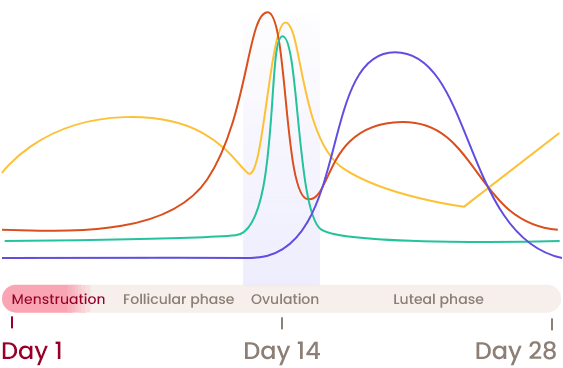
Day 3
Oestrogen, Progesterone, and LH are low while FSH is increasing. This is when most hormone tests are taken.
Day 14
Oestrogen, LH and FSH begin to rise, and peaks sharply when you ovulate. After ovulation, Progesterone rises to prepare the body for pregnancy. If pregnancy hasn't occurred, Progesterone levels decline, and you'll have a period.
Changes during perimenopause
When you enter perimenopause, this pattern begins to change as your oestrogen and progesterone levels slowly decline, causing FSH and LH levels to rise in an attempt to trigger the ovaries to produce more hormones.
The slow decline in oestrogen and progesterone does not happen in a linear pattern. It's much more erratic, making it difficult for current female hormone tests taken on a single day to pick up these changes - especially if it's just testing FSH.
MyFORM® is the only blood test in the UK that can identify if your progesterone, oestrogen, LH and FSH are fluctuating in the correct pattern throughout your menstrual cycle.
Find out if you're in perimenopause
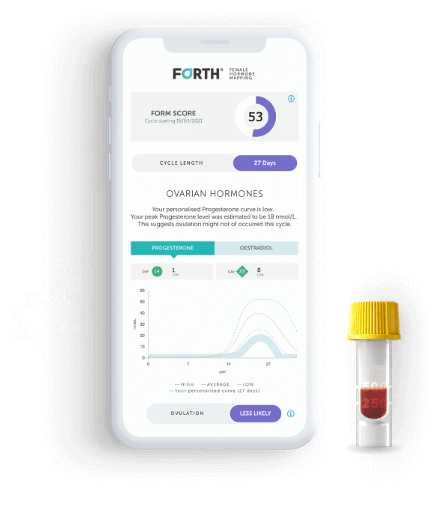
Hormones shouldn't be a mystery.
Our ground-breaking perimenopause blood test maps your hormones across your entire menstrual cycle, helping you to confirm whether you’re in perimenopause, and the strength of your ovarian response.
This test is ideal for women who are not on hormonal contraception or HRT. For those who are, we recommend our Female Hormone Imbalance test.
MyFORM® Perimenopause Blood Test
Understand if symptoms you're experiencing could be due to perimenopause with our ground-breaking hormone mapping test.
NHS lab analysis
x2 finger prick home blood sample kits
Comprehensive hormone report
Tracked 24 delivery & return
Results within 3-5 working days of receiving your second sample
£129
3 Interest-free payments
Learn more

Validated & analysed by NHS Lab
Certified for quality & security
Shop now. Pay over time with Klarna
Klarna available at checkout.
Klarna's Pay in 3 / Pay in 30 days are unregulated credit agreements. Borrowing more than you can afford or paying late may negatively impact your financial status and ability to obtain credit. 18+, UK residents only. Subject to status. Ts&Cs and late fees apply.

The symptoms of perimenopause are often overlooked.
According to our survey, the most commonly experienced symptoms of perimenopause include mood changes, poor sleep, and digestive issues.
For women over 40, it’s hard to know if these symptoms are due to perimenopause, which often leads to a late diagnosis.
We measure all four key hormones during your cycle using two tests
Did you know, there are four key hormones in your menstrual cycle – oestrogen, progesterone, follicle-stimulating hormone and luteinising hormone – and they follow a typical pattern?
+ Read more about hormones
MyFORM® tests all 4 of these hormones. Combining lab analysis with AI we use sophisticated mathematical modelling to map how these hormones fluctuate across your entire menstrual cycle. MyFORM® is the only blood test in the UK that can identify your unique hormone pattern, which is what makes it so revolutionary.
To do this, we only need 2 blood samples taken on day 14 and day 21 of your menstrual cycle, and the process is super easy.
If your menstrual cycle is less than 22 days or more than 40 days, then we recommend our Female Hormone Imbalance test.
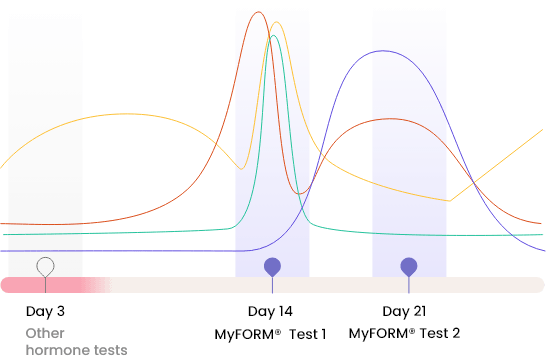
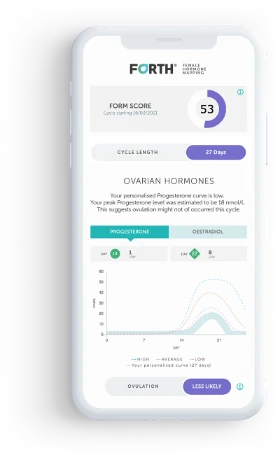
We send you your own, detailed hormone report
You’ll receive a detailed report from our doctors that includes your own, personalised hormone map, results for each hormone tested, your unique ovarian response score (FORM score) which tells you how well your ovaries are functioning, and whether your hormone pattern across your menstrual cycle is indicative of perimenopause. Your report will be available within 3-5 working days of your day 21 sample reaching our lab and can be viewed in your results app.
We use the results to help you end the uncertainty
The results we provide will help end the uncertainty of whether or not your symptoms are due to perimenopause. But that’s not all. Our hormone expert will give you advice on how to manage your symptoms and if you should consider HRT.
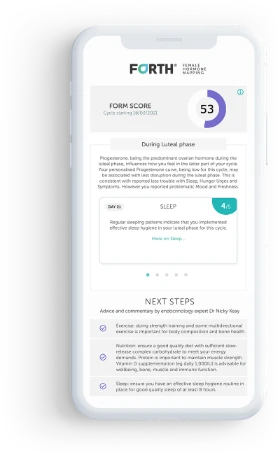
Why MyFORM® is ground breaking
"Our ground-breaking MyFORM® Perimenopause test uses 2 blood sample to map your hormone fluctuations over your entire menstrual cycle. With this, you can identify early onset biomarker changes that can indicate the onset of menopause. Also, as each woman's menopause journey is unique, this tool allows you to track how you're transitioning through the Second Spring."
Dr Thom Phillips
WHAT'S THE PROCESS?
The process is easy
We send you a simple finger prick test kit for you to do at home.
You take two samples: one on day 14 of your cycle, and one on day 21. (Don't worry, we'll tell you when this is!).
You post the samples back to us, free of charge.
We analyse your samples in our NHS lab.
3-5 working days after we've received your second sample you'll get your personalised hormone report.
Join the women's health revolution.
An excellent service, I got fast replies to my enquires and immediate practical solutions. I needed my results quickly after being unable to get samples on my first attempt and Forth found a resolution for me and assisted at each stage. Really great communication from individuals who have the knowledge and ability to sort things out. Wouldn't go anywhere else.
Katie Murray
MyFORM® Perimenopause Blood Test
NHS lab analysis
x2 finger prick home blood sample kits
Comprehensive hormone report
Tracked 24 delivery & return
Results within 3-5 working days of receiving your second sample
Frequently asked questions
This is what our customers ask us most about this test. For more information, try our help centre.
Do I have to take the test during the same menstrual cycle?
Yes. Both blood samples must be taken on day 14 and day 21 of the same menstrual cycle.
What do I do if my day 14 or day 21 falls on a Fri-Sun?
If your day 14 or 21 falls on a Friday, we recommend you collect your sample the day before. If your day 14 or 21 falls over the weekend, collect your sample on the following Monday and remember to post in a priority post box in time for that day’s collection.
Should I change the test days if I have a longer or shorter cycle?
No, our algorithm will adjust your curves to the length of your personal cycle, so it is important that you collect your samples as close to day 14 and 21 as possible, even if you have a longer or shorter than average cycle.
What will the report tell me?
Your report will indicate if your symptoms are likely to be due to perimenopause.
You’ll get a detailed, personalised report with next step actions from an endocrinology expert. The report will tell you:
- If your symptoms are likely due to perimenopause
- Graphs indicating how each hormone fluctuates across your unique cycle
- Your FORM – ovarian response – score indicating how well your ovaries are responding to your control hormones – an indicator of perimenopause
- Personalised ranges for each of the 4 hormones tested on day 14 and day 21
- Confirmation if ovulation has occurred
- Clear next steps and actionable advice
Why can’t I take this test if I’m taking a hormonal contraception or HRT?
Any hormonal contraception or HRT will mask your natural hormone levels. This product has been specifically designed for those who have naturally occurring cycles. If you are using a copper coil you are able to take this test.
What are the 34 symptoms of perimenopause?
Perimenopause comes with a host of psychological and physiological symptoms. The most common symptoms are listed below. You can find out more about each symptom and more about perimenopause in our guide to perimenopause and menopause.
- Irregular periods
- Vaginal dryness
- Increased need to urinate and UTIs
- Breast soreness
- Reduced sex drive (low libido)
- Digestive problems and bloating
- Weight gain
- Hot flushes/night sweats and body odour
- Insomnia, trouble sleeping and sleep disruption
- Fatigue and tiredness
- Anxiety, depression & mood swings
- Memory issues and trouble concentrating (brain fog)
- >Headaches, dizzy spells or vertigo
- Joint pain and muscle tension
- Hair loss and brittle nails
- Dry, itchy skin and acne
How long does perimenopause last?
On average, perimenopause typically lasts up to 10 years[1], but it can vary between women. For some women, perimenopause might last only a few months, while for others, it can extend for more than a decade.
Perimenopause ends when you’ve gone 12 consecutive months without a menstrual period, marking the onset of menopause.
[1]https://www.lscft.nhs.uk/services/service-finder-z/community-pain-service/perimenopause-menopause-and-pain
How to test for perimenopause
The best way to test for perimenopause is to identify your symptoms and have your blood tested. Our ground-breaking MyFORM® Perimenopause test is the only at-home blood test in the UK that can accurately screen for perimenopause, by measuring key hormones on day 14 and 21 of your menstrual cycle.
Forth offers a range of tests for perimenopause, with MyFORM® providing a detailed report into the behaviour of your female hormones during the menstrual cycle. This test can identify when a woman’s hormones are typical of perimenopause and provides actions that can be taken to best manage this transitional phase.
What’s the difference between perimenopause and menopause?
Perimenopause and menopause are different stages of the menopause.
- Perimenopause – a natural transitional phase that leads up to menopause, periods are likely to become less regular and you can experience a range of symptoms. During this phase, oestrogen levels will steadily decline.
- Menopause – this phase is denoted by the end of ovulation, usually defined by more than 12 months since the last period. Oestrogen levels will remain at their lowest levels. The majority of “menopause symptoms” actually refer to those experienced in perimenopause.
When can I start HRT during perimenopause?
It is recommended that you start HRT as soon as you experience symptoms related to perimenopause. Studies have shown that starting HRT earlier in the transition to menopause can reduce the risk of long-term conditions such as: osteoporosis, coronary heart disease, and cardiovascular disease.
You can learn more in the HRT guide on our blog.
How soon will the test arrive?
If you order your test before midday on a Monday to Friday then your kit will be dispatched
the same day.
All our kits are sent out via Royal Mail first class post, so it should be with you within 1-2
working days.
How secure is my data?
We have strict processes in place to ensure the protection of your data. Following GDPR the company also operates under tight legal rules about the sharing of data which ensures that data is only shared if it is crucial to the delivery of our service. For example, our doctors see customer results at the time of review, however, after review, access to results is withdrawn.
Learn more about your data security.
Can I have someone take my blood for me?
Yes. We offer two options if you do not want to do our finger prick test. The first is a home appointment where a nurse comes to your home to take a blood sample. The second is to visit a Phlebotomy clinic near you that offers a blood sample service.
A blood sample will be taken from your vein and we will provide you with everything you need to give to the nurse to allow them to take the sample.
The nurse will give you the blood sample to return to us using the pre-paid envelope provided.
Does a doctor review my results?
We have a team of doctors and nurses who look at all results and will comment on any results that are outside of the normal range for your age.
Can I download the results to share with my GP?
Yes, you can download your results from your health dashboard as a PDF to share with your GP.
Learn how to export your results.
We are dedicated to supporting you on improving your health
Go to help center
MyFORM® Perimenopause Blood Test
£129
Add to basket


